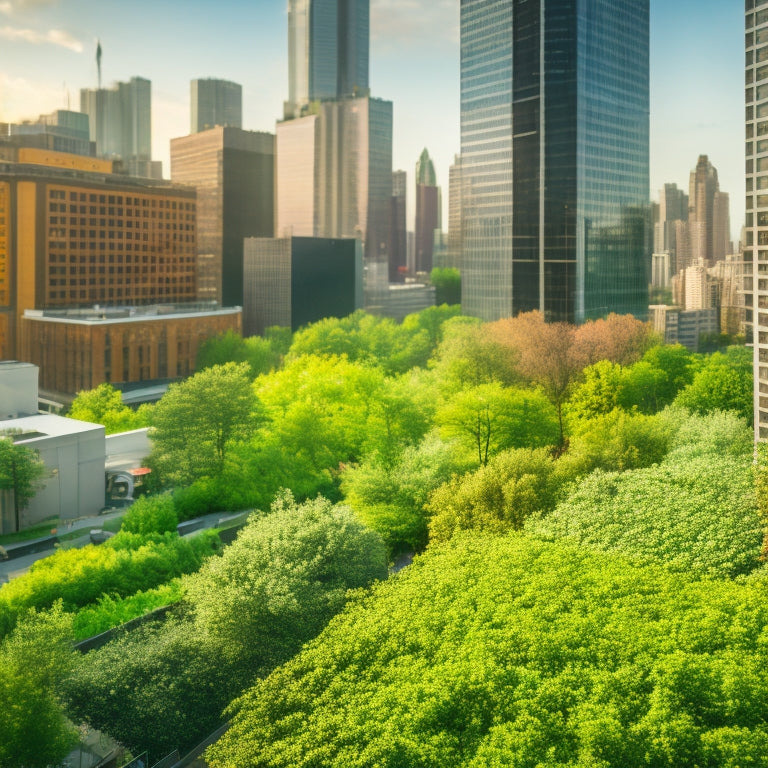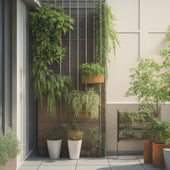
Growing a Greener Future: Rooftop Gardens' Impact
Share
By incorporating rooftop gardens into urban architecture, you're not only lessening the urban heat island effect, but also enhancing air quality, promoting biodiversity, and contributing to a more sustainable cityscape. Rooftop gardens provide shade, cool air through evapotranspiration, and increase a building's albedo, reducing the need for air conditioning. They also serve as habitats for wildlife, conserve stormwater, and increase energy efficiency. By embracing rooftop gardens, you're taking a vital step towards a greener future. Learn how to capitalize on these benefits and unveil the full potential of rooftop gardens for a more environmentally conscious tomorrow.
Urban Heat Island Mitigation
By providing shade, cooling the air through evapotranspiration, and increasing the albedo of a building, rooftop gardens can effectively mitigate the urban heat island effect, which you experience as higher temperatures in cities compared to surrounding rural areas. This is essential, as urban heat islands can lead to increased energy consumption, heat-related illnesses, and mortality.
As you explore ways to create a rooftop garden, consider the significance of community engagement in this process. Involve local residents, businesses, and organizations to raise awareness about the benefits of rooftop gardens and encourage collective action.
To further incentivize this effort, look into policy incentives, such as tax credits, zoning variances, or density bonuses, that can help offset the costs of installing and maintaining a rooftop garden. By combining community engagement with policy incentives, you can create a thorough strategy to mitigate the urban heat island effect and create a more sustainable, livable urban environment.
Air Quality Improvement Strategies
Air Quality Improvement Strategies
You can enhance air quality by incorporating specific plant species into your rooftop garden design, as certain plants are more effective at removing pollutants like particulate matter, ozone, and nitrogen dioxide from the air. When selecting plants, consider those with high pollutant removal rates, such as peace lilies, spider plants, and aloe vera. A well-designed rooftop garden can reduce air pollution by up to 20%.
| Plant Species | Pollutant Removal Rate | Maintenance Requirements |
|---|---|---|
| Peace Lily | High (80%) | Low-maintenance, infrequent watering |
| Spider Plant | Medium (40%) | Medium-maintenance, regular watering |
| Aloe Vera | High (70%) | Low-maintenance, infrequent watering |
| English Ivy | Medium (30%) | High-maintenance, frequent pruning |
| Bamboo Palm | High (60%) | Medium-maintenance, regular watering |
In addition to plant selection, maintenance practices also play an essential role in air quality improvement. Regular pruning, watering, and fertilizing can enhance the pollutant removal capabilities of your rooftop garden. By combining the right plant species with proper maintenance practices, you can create a rooftop garden that not only improves air quality but also provides a peaceful oasis in the midst of a bustling city.
Stormwater Management Solutions
As you design your rooftop garden, incorporating stormwater management solutions can help reduce the burden on urban drainage systems and prevent combined sewer overflows. By integrating green infrastructure, you can effectively manage stormwater runoff and mitigate its impact on the environment.
Permeable surfaces, such as porous pavement or green roofs, allow rainwater to infiltrate the soil, reducing the amount of stormwater that enters the drainage system. This not only alleviates pressure on urban infrastructure but also helps to recharge groundwater aquifers.
Additionally, incorporating vegetation in your rooftop garden can enhance stormwater management by increasing evapotranspiration and reducing surface runoff. When selecting plants, choose species that are adapted to your local climate and can thrive in wet and dry conditions.
Biodiversity Conservation Efforts
Your rooftop garden can also become a sanctuary for urban biodiversity, providing a habitat for local wildlife and supporting conservation efforts. By incorporating native plant species, you're creating a habitat for local insects, birds, and small mammals. This habitat creation not only supports the local ecosystem but also contributes to ecosystem support by providing food, shelter, and breeding grounds.
When designing your rooftop garden, consider incorporating plant diversity to attract a wide range of wildlife. A mix of flowering plants, shrubs, and trees can provide a rich source of nectar, pollen, and seeds. Additionally, consider creating wildlife corridors by connecting your rooftop garden to other green spaces in the area. This can help facilitate the movement of species and promote genetic diversity.
Energy Efficiency Opportunities
By integrating rooftop gardens into building design, you can capitalize on energy efficiency opportunities, reducing the urban heat island effect and lowering energy consumption for heating and cooling. This is especially vital in urban areas where buildings absorb and retain heat, increasing the need for air conditioning and straining the grid.
Rooftop gardens provide natural insulation, reducing the energy required to cool buildings in the summer and heat them in the winter. You can further optimize energy efficiency by incorporating solar panels into your rooftop garden design, generating clean energy and reducing reliance on non-renewable sources.
Insulation optimization is also essential, as it can reduce heat loss in the winter and heat gain in the summer. By combining these strategies, you can create a highly energy-efficient building that not only reduces its carbon footprint but also provides a thriving ecosystem for local wildlife.
Frequently Asked Questions
How Much Weight Can a Typical Rooftop Garden Hold?
You're wondering how much weight your rooftop garden can hold? Well, it depends on the structural limitations and weight capacity of your building, as well as the soil composition and drainage systems you've installed.
Are Rooftop Gardens Only Suitable for Flat Roofs?
You'll find that rooftop gardens aren't limited to flat roofs; with careful design, they can thrive on sloped roofs too, but you'll need to address design challenges, structural considerations, and implement effective drainage solutions.
Can Rooftop Gardens Be Installed on Existing Buildings?
You can install rooftop gardens on existing buildings, but you'll need to take into account structural factors and the installation process, weighing cost implications against environmental benefits, such as reduced stormwater runoff and energy efficiency.
Do Rooftop Gardens Require a Lot of Maintenance?
You're probably thinking rooftop gardens are high-maintenance and expensive, but surprisingly, they're not! They actually require less upkeep than traditional gardens, and the cost is offset by increased property value and sustainability benefits.
Can Rooftop Gardens Be Used for Food Production?
You can use rooftop gardens for food production, leveraging urban agriculture and sustainability to enhance food security. Implementing innovative techniques like hydroponics and vertical farming can increase yields and make the most of your rooftop space.
Related Posts
-

Why Succulents Thrive in DIY Concrete Planters
You've likely noticed that succulents seem to flourish in DIY concrete planters, and it's not just a coincidence - th...
-

Why Succulents Thrive in DIY Concrete Planters
You've likely noticed that succulents seem to flourish in DIY concrete planters, and it's not just a coincidence - th...
-

Why Succulents Thrive in DIY Concrete Planters
You've likely noticed that succulents seem to flourish in DIY concrete planters, and it's not just a coincidence - th...
-

Why Succulents Thrive in DIY Concrete Planters
You've likely noticed that succulents seem to flourish in DIY concrete planters, and it's not just a coincidence - th...
-

Why Succulents Thrive in DIY Concrete Planters
You've likely noticed that succulents seem to flourish in DIY concrete planters, and it's not just a coincidence - th...
-

Why Succulents Thrive in DIY Concrete Planters
You've likely noticed that succulents seem to flourish in DIY concrete planters, and it's not just a coincidence - th...
-

Why Succulents Thrive in DIY Concrete Planters
You've likely noticed that succulents seem to flourish in DIY concrete planters, and it's not just a coincidence - th...
-

Why Succulents Thrive in DIY Concrete Planters
You've likely noticed that succulents seem to flourish in DIY concrete planters, and it's not just a coincidence - th...
-

Why Succulents Thrive in DIY Concrete Planters
You've likely noticed that succulents seem to flourish in DIY concrete planters, and it's not just a coincidence - th...
-

Why Succulents Thrive in DIY Concrete Planters
You've likely noticed that succulents seem to flourish in DIY concrete planters, and it's not just a coincidence - th...
-

Why Succulents Thrive in DIY Concrete Planters
You've likely noticed that succulents seem to flourish in DIY concrete planters, and it's not just a coincidence - th...
-

Why Succulents Thrive in DIY Concrete Planters
You've likely noticed that succulents seem to flourish in DIY concrete planters, and it's not just a coincidence - th...
-

Why Succulents Thrive in DIY Concrete Planters
You've likely noticed that succulents seem to flourish in DIY concrete planters, and it's not just a coincidence - th...
-

Why Succulents Thrive in DIY Concrete Planters
You've likely noticed that succulents seem to flourish in DIY concrete planters, and it's not just a coincidence - th...
-

Why Succulents Thrive in DIY Concrete Planters
You've likely noticed that succulents seem to flourish in DIY concrete planters, and it's not just a coincidence - th...
-

Why Succulents Thrive in DIY Concrete Planters
You've likely noticed that succulents seem to flourish in DIY concrete planters, and it's not just a coincidence - th...
-

Why Succulents Thrive in DIY Concrete Planters
You've likely noticed that succulents seem to flourish in DIY concrete planters, and it's not just a coincidence - th...
-

What's the Ideal Timeline for a Concrete Planter Reno
You'll need to allocate around 6-12 weeks for a concrete planter renovation, broken down into seven distinct phases t...
-

What's the Ideal Timeline for a Concrete Planter Reno
You'll need to allocate around 6-12 weeks for a concrete planter renovation, broken down into seven distinct phases t...
-

What's the Ideal Timeline for a Concrete Planter Reno
You'll need to allocate around 6-12 weeks for a concrete planter renovation, broken down into seven distinct phases t...
-

What's the Ideal Timeline for a Concrete Planter Reno
You'll need to allocate around 6-12 weeks for a concrete planter renovation, broken down into seven distinct phases t...
-

What's the Ideal Timeline for a Concrete Planter Reno
You'll need to allocate around 6-12 weeks for a concrete planter renovation, broken down into seven distinct phases t...
-

What's the Ideal Timeline for a Concrete Planter Reno
You'll need to allocate around 6-12 weeks for a concrete planter renovation, broken down into seven distinct phases t...
-

What's the Ideal Timeline for a Concrete Planter Reno
You'll need to allocate around 6-12 weeks for a concrete planter renovation, broken down into seven distinct phases t...
-

What's the Ideal Timeline for a Concrete Planter Reno
You'll need to allocate around 6-12 weeks for a concrete planter renovation, broken down into seven distinct phases t...
-

What's the Ideal Timeline for a Concrete Planter Reno
You'll need to allocate around 6-12 weeks for a concrete planter renovation, broken down into seven distinct phases t...
-

What's the Ideal Timeline for a Concrete Planter Reno
You'll need to allocate around 6-12 weeks for a concrete planter renovation, broken down into seven distinct phases t...
-

What's the Ideal Timeline for a Concrete Planter Reno
You'll need to allocate around 6-12 weeks for a concrete planter renovation, broken down into seven distinct phases t...
-

What's the Ideal Timeline for a Concrete Planter Reno
You'll need to allocate around 6-12 weeks for a concrete planter renovation, broken down into seven distinct phases t...
-

What's the Ideal Timeline for a Concrete Planter Reno
You'll need to allocate around 6-12 weeks for a concrete planter renovation, broken down into seven distinct phases t...
-

What's the Ideal Timeline for a Concrete Planter Reno
You'll need to allocate around 6-12 weeks for a concrete planter renovation, broken down into seven distinct phases t...
-

What's the Ideal Timeline for a Concrete Planter Reno
You'll need to allocate around 6-12 weeks for a concrete planter renovation, broken down into seven distinct phases t...
-

What's the Ideal Timeline for a Concrete Planter Reno
You'll need to allocate around 6-12 weeks for a concrete planter renovation, broken down into seven distinct phases t...
-

What's the Ideal Timeline for a Concrete Planter Reno
You'll need to allocate around 6-12 weeks for a concrete planter renovation, broken down into seven distinct phases t...
-

What's the Ideal Timeline for a Concrete Planter Reno
You'll need to allocate around 6-12 weeks for a concrete planter renovation, broken down into seven distinct phases t...
-

What's the Ideal Timeline for a Concrete Planter Reno
You'll need to allocate around 6-12 weeks for a concrete planter renovation, broken down into seven distinct phases t...
-

What's the Ideal Timeline for a Concrete Planter Reno
You'll need to allocate around 6-12 weeks for a concrete planter renovation, broken down into seven distinct phases t...
-

What's the Ideal Timeline for a Concrete Planter Reno
You'll need to allocate around 6-12 weeks for a concrete planter renovation, broken down into seven distinct phases t...
-

3 Best Space-Saving Gardening Ideas for Urban Renters
You can turn even the smallest urban space into a lush oasis by utilizing clever space-saving gardening ideas. Maximi...
-

3 Best Space-Saving Gardening Ideas for Urban Renters
You can turn even the smallest urban space into a lush oasis by utilizing clever space-saving gardening ideas. Maximi...
-

3 Best Space-Saving Gardening Ideas for Urban Renters
You can turn even the smallest urban space into a lush oasis by utilizing clever space-saving gardening ideas. Maximi...
-

3 Best Space-Saving Gardening Ideas for Urban Renters
You can turn even the smallest urban space into a lush oasis by utilizing clever space-saving gardening ideas. Maximi...
-

3 Best Space-Saving Gardening Ideas for Urban Renters
You can turn even the smallest urban space into a lush oasis by utilizing clever space-saving gardening ideas. Maximi...
-

3 Best Space-Saving Gardening Ideas for Urban Renters
You can turn even the smallest urban space into a lush oasis by utilizing clever space-saving gardening ideas. Maximi...
-

3 Best Space-Saving Gardening Ideas for Urban Renters
You can turn even the smallest urban space into a lush oasis by utilizing clever space-saving gardening ideas. Maximi...
-

3 Best Space-Saving Gardening Ideas for Urban Renters
You can turn even the smallest urban space into a lush oasis by utilizing clever space-saving gardening ideas. Maximi...
-

3 Best Space-Saving Gardening Ideas for Urban Renters
You can turn even the smallest urban space into a lush oasis by utilizing clever space-saving gardening ideas. Maximi...
-

3 Best Space-Saving Gardening Ideas for Urban Renters
You can turn even the smallest urban space into a lush oasis by utilizing clever space-saving gardening ideas. Maximi...
-

3 Best Space-Saving Gardening Ideas for Urban Renters
You can turn even the smallest urban space into a lush oasis by utilizing clever space-saving gardening ideas. Maximi...
-

3 Best Space-Saving Gardening Ideas for Urban Renters
You can turn even the smallest urban space into a lush oasis by utilizing clever space-saving gardening ideas. Maximi...
-

3 Best Space-Saving Gardening Ideas for Urban Renters
You can turn even the smallest urban space into a lush oasis by utilizing clever space-saving gardening ideas. Maximi...
-

3 Best Space-Saving Gardening Ideas for Urban Renters
You can turn even the smallest urban space into a lush oasis by utilizing clever space-saving gardening ideas. Maximi...


